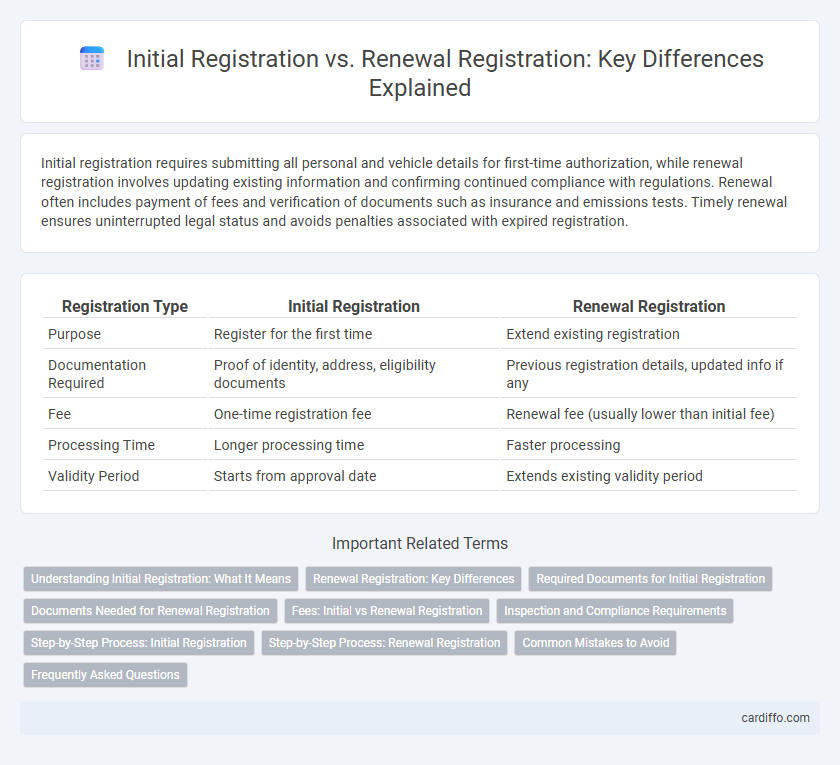Initial registration requires submitting all personal and vehicle details for first-time authorization, while renewal registration involves updating existing information and confirming continued compliance with regulations. Renewal often includes payment of fees and verification of documents such as insurance and emissions tests. Timely renewal ensures uninterrupted legal status and avoids penalties associated with expired registration.
Table of Comparison
| Registration Type | Initial Registration | Renewal Registration |
|---|---|---|
| Purpose | Register for the first time | Extend existing registration |
| Documentation Required | Proof of identity, address, eligibility documents | Previous registration details, updated info if any |
| Fee | One-time registration fee | Renewal fee (usually lower than initial fee) |
| Processing Time | Longer processing time | Faster processing |
| Validity Period | Starts from approval date | Extends existing validity period |
Understanding Initial Registration: What It Means
Initial registration refers to the first time an individual or entity officially enrolls or signs up for a service, program, or legal status, establishing their formal presence in the system. This process involves submitting required documentation, verifying identity, and meeting eligibility criteria for the specific registration type. Unlike renewal registration, which updates or extends an existing record, initial registration creates a new account or profile that enables access and participation.
Renewal Registration: Key Differences
Renewal registration involves updating existing credentials to maintain active status, whereas initial registration requires first-time submission of all necessary documentation and verification. Key differences include streamlined procedures for renewal, often with reduced paperwork and faster processing times. Renewal registration typically requires proof of continuing eligibility, such as updated certifications or compliance with regulatory standards.
Required Documents for Initial Registration
For Initial Registration, applicants must submit original identification documents such as government-issued ID, proof of address, and a completed registration form. Supporting materials like birth certificates, social security numbers, and proof of payment for registration fees are also necessary. Renewal Registration typically only requires updated identification and proof of previous registration, minimizing document submission compared to Initial Registration.
Documents Needed for Renewal Registration
Renewal registration requires submitting updated identification documents, proof of address, and the current registration certificate to verify continued eligibility. Unlike initial registration, which demands comprehensive paperwork including birth certificates and initial proof of residency, renewal focuses on validating existing information and any changes since the last registration period. Ensuring all renewal documents are accurate and current speeds up the registration renewal process and maintains compliance with regulatory standards.
Fees: Initial vs Renewal Registration
Initial registration fees are typically higher than renewal fees due to administrative processing and account setup costs. Renewal registration fees are often discounted to encourage ongoing compliance and continuous use of the service or product. Comparing the fee structures reveals cost efficiency benefits for users who maintain active registration over time.
Inspection and Compliance Requirements
Initial registration mandates a comprehensive inspection to verify compliance with safety, emissions, and operational standards established by regulatory authorities. Renewal registration typically requires proof of continued compliance, such as valid inspection certificates or emissions test results, ensuring ongoing adherence to legal and environmental regulations. Failure to meet these inspection and compliance requirements can result in registration denial or penalties.
Step-by-Step Process: Initial Registration
Initial registration involves completing a detailed application form and submitting required identification documents to verify eligibility. Applicants must provide proof of residency, pay applicable fees, and complete any mandatory training or certification programs specific to the registration type. The process culminates with a confirmation receipt and issuance of an official registration number or certificate.
Step-by-Step Process: Renewal Registration
Renewal registration involves verifying existing account details, updating any changes such as contact information or documents, and submitting the renewal application through the official portal. Payment of renewal fees is required to complete the process, followed by receiving confirmation via email or SMS within a specified timeframe. Timely renewal prevents service interruptions and maintains compliance with regulatory requirements.
Common Mistakes to Avoid
Common mistakes during initial registration include providing incomplete documentation and incorrect personal information, which can delay processing. For renewal registration, failing to update expired credentials or missing renewal deadlines are frequent errors that lead to penalties or service interruptions. Verifying all submitted data and adhering to deadlines ensures a smooth registration process.
Frequently Asked Questions
Initial registration requires submitting all necessary documentation and fulfilling eligibility criteria for first-time approval, while renewal registration involves updating existing records and confirming continued eligibility. Common questions include required documents, deadlines for submission, fees involved, and how to correct errors in submitted information. Understanding these differences ensures smooth processing and avoids penalties or service interruptions.
Initial Registration vs Renewal Registration Infographic

 cardiffo.com
cardiffo.com